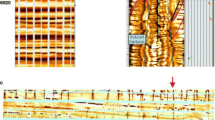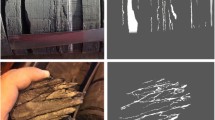Abstract
The finite element analysis (FEA) technology by hydraulic-mechanical-chemical-damage (HMCD) coupling is proposed in this paper for inclined wellbore stability analysis of water-sensitive and laminated rock, developed basing on the recently established FEA technology for transversely isotropic rock with hydraulic-mechanical-damage (HMD) coupling. The chemical activity of the drilling fluid is considered as phenomenological hydration behavior, the moisture content and parameters of rock considering hydration could be determined with time. The finite element (FE) solutions of numerical wellbore model considering the chemical activity of drilling fluid, damage tensor calculation and weak plane strength criterion for transversely isotropic rock are developed for researching the wellbore failure characteristics and computing the time-dependent collapse and fracture pressure of laminated rock as shale reservoirs. A three-dimensional FE model and elastic solid deformation and seepage flow coupled equations are developed, and the damage tensor calculation technology for transversely isotropic rock are realized by introducing effect of the hydration and the stress state under the current load. The proposed method utilizing weak plane strength criterion fully reflects the strength parameters in rock matrix and weak plane. To the end, an effective and reliable numerically three-step FEA strategy is well established for wellbore stability analysis. Numerical examples are given to show that the proposed method can establish efficient and applicable FE model and be suitable for analyzing the timedependent solutions of pore pressure and stresses, and the evolution region considering the hydration surrounding wellbore, furthermore to compute the collapse cycling time and the safe mud weight for collapse and fracture pressure of transversely isotropic rock.
Similar content being viewed by others
References
Zhuang Z, Liu Z L, Wang Y L. Fundamental theory and key mechanical problems of shale oil gas effective extraction (in Chinese). Chin Q Mech, 2015, 33: 8–17
Lo T, Coyner K B, Toksöz M N. Experimental determination of elastic anisotropy of Berea sandstone, Chicopee shale, and Chelmsford granite. Geophys, 1986, 51: 164–171
Abousleiman Y N, Hoang S K, Tran M H. Mechanical characterization of small shale samples subjected to fluid exposure using the inclined direct shear testing device. Int J Rock Mech Min Sci, 2010, 47: 355–367
Yang H L, Shen R C, Fu L. Composition and mechanical properties of gas shale (in Chinese). Pet Drill Tech, 2013, 41: 31–35
Nguyen V X, Abousleiman Y N, Hoang S. Analyses of wellbore instability in drilling through chemically active fractured-rock formations. SPE J, 2009, 14: 283–301
Bažant Z P, Salviato M, Chau V T, et al. Why fracking works. J Appl Mech, 2014, 81: 1–10
Abousleiman Y N, Nguyen V X. PoroMechanics response of inclined wellbore geometry in fractured porous media. J Eng Mech, 2005, 131: 1170–1183
Nguyen V X, Abousleiman Y N. Naturally fractured reservoir three-dimensional analytical modeling: theory and case study. In: SPE Annual Technical Conference and Exhibition. Society of Petroleum Engineers, 2009
Chen S L, Abousleiman Y N. Stress analysis of borehole subjected to fluid injection in transversely isotropic poroelastic medium. Mech Res Commun, 2016, 73: 63–75
Hoang S, Abousleiman Y N, Ewy R T. Openhole stability and solids production simulation in emerging reservoir shale using transversely isotropic thick wall cylinders. In: SPE Annual Technical Conference and Exhibition. Society of Petroleum Engineers, 2009
Lu Y H, Chen M, Jin Y, et al. A mechanical model of borehole stability for weak plane formation under porous floe. Pet Sci Tech, 2012, 30: 1629–1638
Xiao Y, Liu H, Desai C S, et al. Effect of intermediate principal stress ratio on particle breakage of rockfill material. J Geotech Geoenviron Eng, 2016, 142: 06015017
Zhao Y P, Chen J, Yuan Q, et al. Microcrack connectivity in rocks: a real-space renormalization group approach for 3D anisotropic bond percolation. J Stat Mech: Theory Exp, 2016, 2016: 013205
Zhuang Z, Cheng B B. A novel enriched CB shell element method for simulating arbitrary crack growth in pipes. Sci China Phys Mech Astron, 2011, 54: 1520–1531
Zeng Q L, Liu Z L, Xu D D, et al. Modeling stationary and moving cracks in shells by X-FEM with CB shell elements. Sci China Tech Sci, 2014, 57: 1276–1284
Krajcinovic D, Lemaitre J. Continuum Damage Mechanics Theory and Applications. New York: Springer-Verlag, 1987
Zhu W C, Bruhns O T. Simulating excavation damaged zone around a circular opening under hydromechanical conditions. Inter J Rock Mech Min Sci, 2008, 45: 815–830
Lu Y L, Elsworth D, Wang L G. Microcrack-based coupled damage and flow modeling of fracturing evolution in permeable brittle rocks. Comput Geotech, 2013, 49: 226–244
Wang Y L, Liu Z L, Lin S C, et al. Finite element analysis of seepage in rock based on continuum damage evolution (in Chinese). Eng Mech, 2016, 33: 29–37
Wang Y L, Liu Z L, Yang H L, et al. FE analysis of rock with hydraulic- mechanical coupling based on continuum damage evolution. Math Probl Eng, 2016, doi: 10.1155/2016/8534965
Wang Y L, Liu Z L, Yang H L, et al. Finite element analysis for wellbore stability of transversely isotropic rock with hydraulic-mechanical-damage coupling. Sci China Tech Sci, doi: 10.1007/s11431-016-6070-x
Wang Y L, Zhuang Z, Liu Z L, et al. Finite element analysis of transversely isotropic rock with mechanical-chemical-damage coupling. Eng Mech, 2016, doi: 10.6052/j.issn.1000-4750.2016.04.0287
Mortara G. A yield criterion for isotropic and cross-anisotropic cohesive- frictional materials. Int J Numer Anal Met, 2010, 34: 953–977
Xiao Y, Liu H L, Yang G. Formulation of cross-anisotropic failure criterion for granular material. Int J Geomech, 2012, 12: 182–188
Hill R. The Mathematical Theory of Plasticity. Oxford: Oxford University Press, 1950
Pariseau W G. Plasticity theory for anisotropic rocks and soils. In: Proceedings of the 10th U.S. Symposium on Rock Mechanics. American Rock Mechanics Association, 1968. 267–295
Lee H, Ong S H, Azeemuddin M, et al. A wellbore stability model for formations with anisotropic rock strengths. J Pet Sci Eng, 2012, 96: 109–119
Lee H, Chang C, Ong S H, et al. Effect of anisotropic borehole wall failures when estimating in situ stresses: A case study in the Nankai accretionary wedge. Mar Pet Geol, 2013, 48: 411–422
Biot M A. General theory of three-dimensional consolidation. J Appl Phys, 1941, 12: 155–164
Biot M A. Theory of stress-strain relations in anisotropic viscoelasticity and relaxation phenomena. J Appl Phys, 1954, 25: 1385–1391
Detourmay E, Cheng A H D. Fundamentals of Poroelasticity. Oxford: Pergamon, 1993
Cheng A H D. Material coefficients of anisotropic poroelasticity. Inter J Rock Mech Min Sci, 1997, 34: 199–205
Dokhani V, Yu M, Takach N E, et al. The role of moisture adsorption in wellbore stability of shale formations: Mechanism and modeling. J Nat Gas Sci Eng, 2015, 27: 168–177
Huang R Z, Chen M, Deng J G, et al. Study on shale stability of wellbore by mechanics coupling with chemistry method (in Chinese). Drill Fluid Compl Fluid, 1995, 12: 15–21
COMSOL Multiphysics User’s Guide. Version 5.0. Stockholm: COMSOL Inc., 2014
Jean L. Coupled elasto-plasticity and damage constitutive equations. Comput Methods Appl Mech Eng, 1985, 51: 31–49
Jaeger J C, Cook N G W. Fundamentals of Rock Mechanics. Houston: Blackwell Publishing, 1983
Krajcinovic D. Damage mechanics: Accomplishments, trends and needs. Inter J Solids Struct, 2000, 37: 267–277
Zhu W C, Bruhns O T. Simulating excavation damaged zone around a circular opening under hydromechanical conditions. Inter J Rock Mech Min Sci, 2008, 45: 815–830
Tran M H, Abousleiman Y N. Anisotropic porochemoelectroelastic solution for an inclined wellbore drilled in shale. J Appl Mech, 2013, 80: 020912
Yang H L, Chen C W, Wang J H, et al. Technical report of experimental study of shale drilling (in Chinese). Beijing: Drilling Research Institute, China National Petroleum Corporation, 2013
Author information
Authors and Affiliations
Corresponding author
Electronic supplementary material
11431_2016_460_MOESM1_ESM.docx
Finite element analysis for inclined wellbore stability of transversely isotropic rock with HMCD coupling based on weak plane strength criterion
Rights and permissions
About this article
Cite this article
Wang, Y., Zhuang, Z., Liu, Z. et al. Finite element analysis for inclined wellbore stability of transversely iso-tropic rock with HMCD coupling based on weak plane strength criterion. Sci. China Technol. Sci. 60, 624–637 (2017). https://doi.org/10.1007/s11431-016-0460-2
Received:
Accepted:
Published:
Issue Date:
DOI: https://doi.org/10.1007/s11431-016-0460-2




